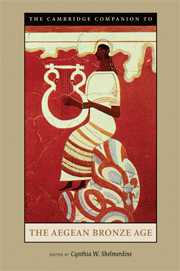Book contents
- Frontmatter
- 1 Background, Sources, and Methods
- 2 The Early Bronze Age in Greece
- 3 The Early Bronze Age in the Cyclades
- 4 Early Prepalatial Crete
- 5 Protopalatial Crete
- 5A Formation of the Palaces
- 5B The Material Culture
- 6 The Material Culture of Neopalatial Crete
- 7 Minoan Culture: Religion, Burial Customs, and Administration
- 8 Minoan Crete and the Aegean Islands
- 9 Minoan Trade
- 10 Early Mycenaean Greece
- 11 Mycenaean Art and Architecture
- 12 Mycenaean States
- 13 Burial Customs and Religion
- 14 Mycenaean Greece, the Aegean and Beyond
- 15 Decline, Destruction, Aftermath
- Glossary
- Select Bibliography
- Index
- Plate section
5A - Formation of the Palaces
from 5 - Protopalatial Crete
Published online by Cambridge University Press: 28 November 2010
- Frontmatter
- 1 Background, Sources, and Methods
- 2 The Early Bronze Age in Greece
- 3 The Early Bronze Age in the Cyclades
- 4 Early Prepalatial Crete
- 5 Protopalatial Crete
- 5A Formation of the Palaces
- 5B The Material Culture
- 6 The Material Culture of Neopalatial Crete
- 7 Minoan Culture: Religion, Burial Customs, and Administration
- 8 Minoan Crete and the Aegean Islands
- 9 Minoan Trade
- 10 Early Mycenaean Greece
- 11 Mycenaean Art and Architecture
- 12 Mycenaean States
- 13 Burial Customs and Religion
- 14 Mycenaean Greece, the Aegean and Beyond
- 15 Decline, Destruction, Aftermath
- Glossary
- Select Bibliography
- Index
- Plate section
Summary
Introduction
The archaeology of prehistoric Crete is dominated by the Minoan “palaces”: monumental court-centered building compounds, which first appeared in the early second millennium bce. By the Neopalatial period of the mid-second millennium bce, they are found (or predicted) in various sizes and configurations all over the island. Arthur Evans' uncovering of the 1-hectare (10,000 sq. m. or about 2.5 acres) palace at Knossos startled the Classical world at the beginning of the twentieth century ce, with both its scale and early date (Fig. 6.1). The grand, pre-Classical civilization that could build such an edifice seemed at least a junior member of the great ancient Near Eastern world of palaces and temples that was revealed to the colonial powers during the nineteenth century ce. Evans’s vision of a “priest-king” at the top of a hierarchical theocratic power structure has remained in some form the dominant interpretative paradigm ever since.
Furthermore, the Minoan palace was seen from its creation as the centralized redistributive authority for a wider territory. This was an anachronistic inference from the Late Bronze Age palaces. The decipherment in 1952 of Linear B records recovered from the Late Minoan II–IIIA2 palace of Knossos, and also Pylos and Mycenae in mainland Greece, seemed to show that the Minoan–Mycenaean palaces were the centers of elaborate palace economies like those in the Near East, with goods redistributed through or by rulers and officials at the palaces (Chs. 1, pp. 12–14; 12, pp. 291–2).
- Type
- Chapter
- Information
- The Cambridge Companion to the Aegean Bronze Age , pp. 105 - 120Publisher: Cambridge University PressPrint publication year: 2008
- 9
- Cited by



